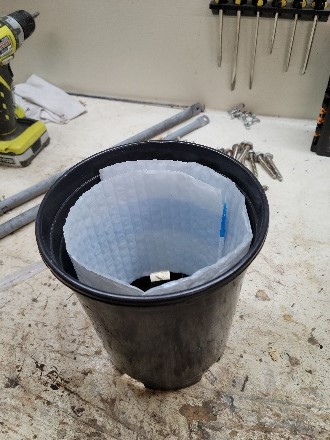
by Stan Logan | Nov 23, 2021 | Container plants, Irrigation
Cindy Eastman has her own method of dealing with hot pots. She lines the inside of her gallon pots with bubble wrap. If you are like me (sorry), you have a number of bubble wrap delivery pouches laying around waiting to be stuffed into the recycle bin of your local store. Consider re-using the plastic by cutting the bags into strips that can be wound around the inside of your black plastic pots. If you would like to show your gardening friends how clever you are, cut the strips a little wider so that they show above the soil level. I’m sure their curiosity will lead to fascinating conversation.
Stan, The Re-user Man

Bubble wrap lining a garden pot
P.S. The pot pictured looks quite tapered, but it is just the angle of the camera. I appreciate those of you who have been responding to my blogs. It often gives me ideas for future articles.
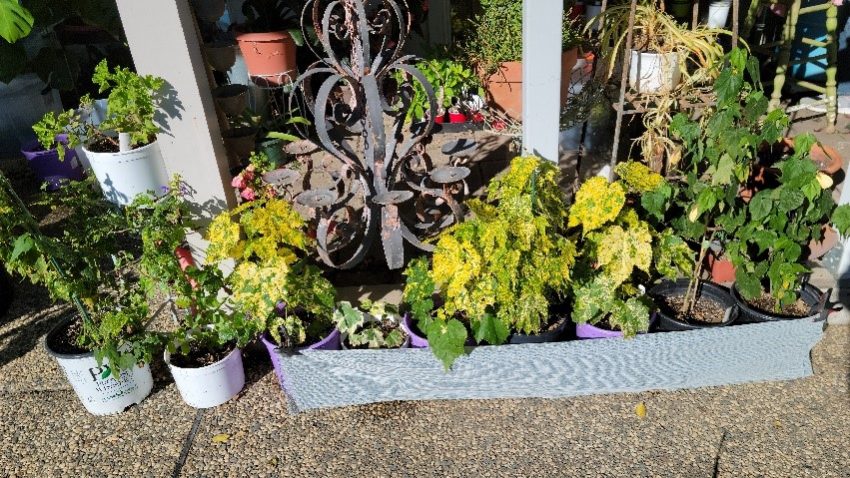
by Stan Logan | Nov 12, 2021 | Container plants, Irrigation
I suspect that many of you are growing plants in black plastic pots. The reason, or course, is that they are free. Whether they are small 4 inch square pots or 3 gallon round ones, there is always a free source for these containers. My main source is the Redwood Barn nursery in Davis. Customers constantly return used pots to the nursery for re-use. My concern is that you remember that these black pots are easily heated by the sun, and root damage can result. Even though the sun’s rays are less intense in the Winter, the rays are coming in at a lower angle and strike the sides of your pots more directly. The air is cooler now, but the sun can still release a great deal of heat into the soil of your potted plants.
If you are growing plants that prefer full sun, you can still use various techniques to shade the pots. I’ve shown one of these below where I have clamped shade cloth in front of the black pots. Hopefully you have a more esthetic technique in practice. Notice that the white pots on the end have no sun shield because they naturally reflect the sunlight and don’t convert it into heat. So, if you wish to avoid the whole problem, use white pots. I noticed that Amazon has a great selection from 3 inch to 7 gallons. White pots show plants better anyway, don’t you think?
By the way, LaVille plants most of her “mother” plants for propagation in white pots—pots that will not go to sales by accident.
Stan, The Cool Man

White pots and shielded pots
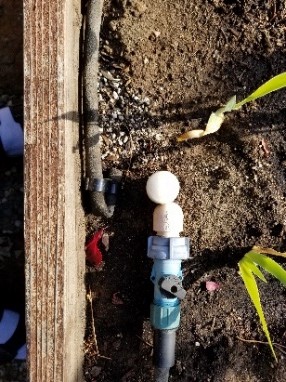
by Stan Logan | May 27, 2021 | Container plants, Garden tools, Irrigation
With all the pandemic caused emphasis on home improvement, this would have been a good article to write a year ago. Better late than never. As usual, wanting to advise others comes as a result of mistakes I have made, some of which are described below.
Size: Length can be whatever you want. Width, however, should be no more than 4 feet. I have 3 beds that are 5 feet by 8 feet and it is difficult to do any work near the center of the beds. The one 4 footer is so much easier. The walls of my beds are made with three 2 x 6’s, so they are about 18 inches high. Now that I think of it, 24 inches would have been much better in terms of having to bend over less. But then, I think proportions look better at 18”—you gotta look good even if it’s painful. The higher you raise the box, the stronger the support needed to keep boards from bowing out if they are long. People use raised beds to make tending them easier and to create an enclosure for the new improved soil that can be brought in that, hopefully, plants will love. Most people find that a bed 10 or 12 inches high works well for them—not so much for growing tomatoes which are best planted 18 inches down.
Materials: Most people use wood. Redwood is probably the best. When you are picking out your 2-by boards, try to find those that have the most heartwood. The reddish heartwood is far more resistant to rot than the pale sapwood. Cedar is another good choice. Pressure treated wood is more controversial. No arsenic has been used in this wood since 2003-4. Currently 2 different copper compounds are used and although no traces of these chemicals have been found in either soil or vegetables, pressure treated wood is not recommended for planter boxes in which food is grown. You can alleviate you fears by lining the box with heavy plastic—say 6 mil. You can also seal the box with paint or another kind of sealer. One caution—avoid breathing the dust when cutting pressurized wood. Wear a mask. I know you know how to do that. More expensive, but far more durable is construction with masonry. There are all kinds of attractive alternatives here. The drawback is that you have to lean over farther to work with your plants and the material is not gentle on elbows and knees
Misc. Plan ahead and bring irrigation lines up into the box. Cover the bottom with hardware cloth—you know, the substantial ¼” wire mesh, to keep varmints out. A layer of weed cloth will also discourage the invasion of roots from a nearby tree. Trust me—tree roots will love the great soil and water you have provided. If you are using wood, consider installing flat boards on the top edges for ease of sitting. Don’t just use screws to hold lumber together. Use lag screws, or better yet, use bolts with washers. If using lag screws, predrill to prevent splitting. You can attach a band of copper mesh around the outside to keep snails and slugs out—but not earwigs. Finally, as you can see below, if you use treated posts, you have to add preservative, sealer, or a cap to cuts that have exposed untreated interior areas.
 In-box irrigation |
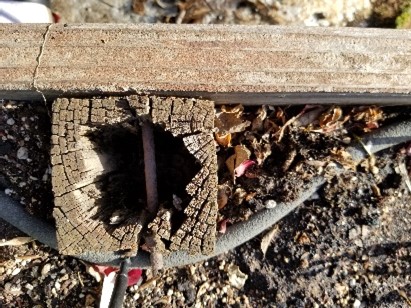 Rotting post |
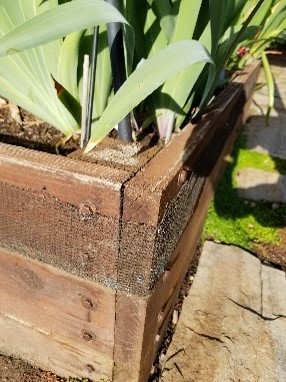 Copper mesh |
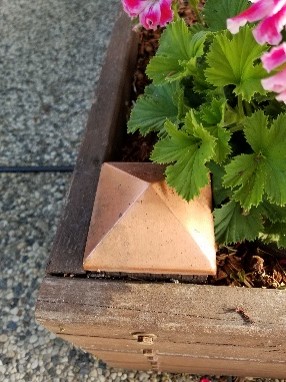 Post cap |
Why does most of my learning have to come at the expense of mistakes I have made?
Stan, The Blog Man
by Stan Logan | May 20, 2020 | Container plants
I knew that title would get your interest. Now that I have you, let me tell you about something I learned about replanting potted plants. LaVille and I learned this while watching Gardener’s World on Prime Video. It seems so simple, that I am almost embarrassed not to have known of it before. When you are transplanting a potted plant either into a larger pot or into the ground, dig your hole, and then place the entire pot into the hole. Adjust for height and add soil around the pot. Firm it up. Lift the pot and its plant out of the soil. Pop the plant out of its pot and drop it into the perfectly formed hole. If the plant is so overgrown that it interferes with packing soil around it, first remove the plant from the pot, set it aside, and use the empty pot to form the new hole. For better growth results LaVille always adds Sure Start to the hole.
I hope you will remember this technique the next time you do your planting. It is really efficient and effective.
Stan
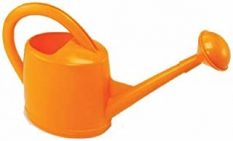
by Stan Logan | May 20, 2020 | Container plants, Irrigation
Every now and then I get a good idea. I think the last time was June 14, 2005. This new idea cannot be claimed as my own, but then at least the plan to pass it on to you is my own.
I was watching an episode of Gardeners’ World on Amazon Prime when they had a segment about a lady who had a garden with 1,259 pots—and I don’t mean dinky ones. These were all different and some were quite large. Sounds crazy, huh? Apparently she inherited this pot fetish from her mother who had 700 pots. Now, this is not the significant part. What is—is that she watered all of these by hand using a watering can that she dipped into 21 different dipping containers that were spread throughout the garden. These 21 reservoirs are kept filled by a drip system. Now maybe you don’t mind dragging a hose around the garden, particularly if you have own of those expandable hoses that is light weight. But consider this: What if you had a large garbage can that was in a convenient place in the garden that you could fill once in a while and add a light dose of fertilizer. Now besides not having a hose to mess which each time you water, you are regularly giving your plants extra nutrients. Good idea?
We have been using this system for a month now. I use a pump and long hose to fill two 55 gallon barrels—one on each side of the yard. The water comes from our koi pond so it already has fertilizer added. The plants absolutely love it. LaVille uses a watering can that has a handle that runs fore and aft, so she can water with one hand with the other one free to test the soil moisture of each pot. She only has one good arm left anyway.
She frequently loses track of the watering can, so I tried buying another. I finally found the right style on Amazon Prime. (Dramm 7 Liter Watering Can 12433, $38.22) There are many models that are far less expensive, but they all have bales that are mounted crosswise.

Watering Can
So even if you don’t have a pot fetish, you may want to try out this new idea. LaVille would never admit to a fetish, but with the added SPPC plants, she does have over 250 outside containers and 50 inside.
Stan, The Tool Man
by Stan Logan | Aug 19, 2018 | Container plants
Pot Bound?
No, I’m not asking whether you are heading to the closest pot dispensary. Nor am I referring the condition of a plant that has cemented itself into a pot with excessive root growth. I am asking if you are bound to your garden because you have so many potted plants that you can’t go anywhere because they have to be watered so often.
I suspected we had pot bound disease, but it really came to light as we left the last SPPC meeting. I was trying to get rid of some pots left over from the tools and treasures table, and I asked Pat McKnight if she wanted a pot. She exclaimed that the only plants she had were in the ground. What a smart lady! On the other hand we have pots . . lots of pots. I decided to count them and I came up with over 200. So if anyone is pot bound, it is we. This year we scheduled no trips between March and August. In August we have a gardening friend who will come over a couple times to keep all the potted plants alive. My goal for the future is to reduce the number of potted plants so that we will be vacation bound when the weather heats up. What’s your situation? Do you likewise feel the urge to be pot free?
Stan








